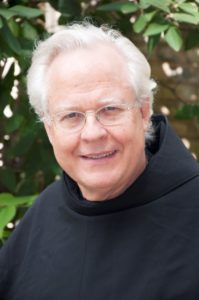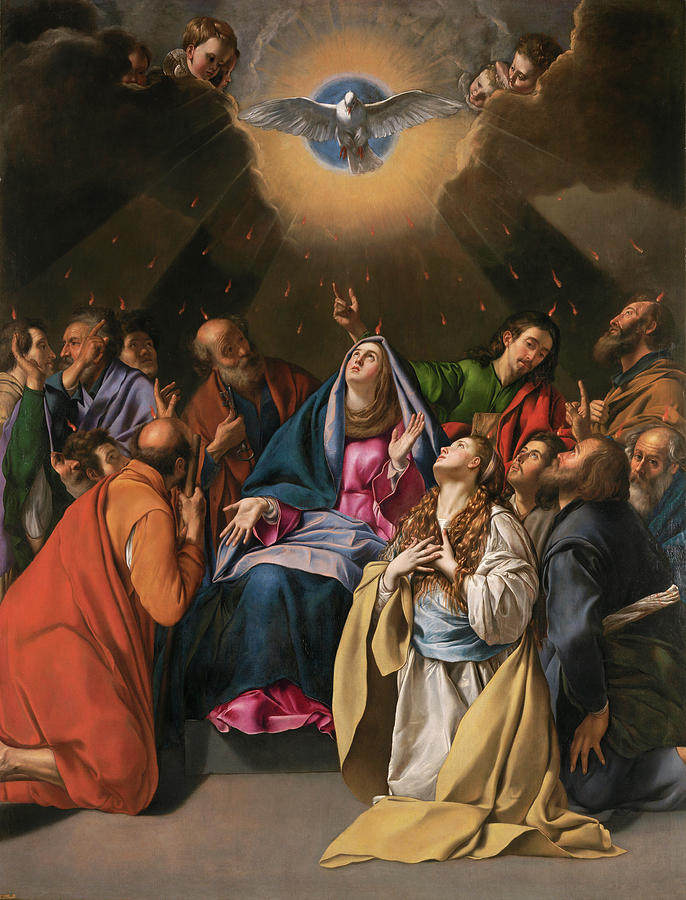The Scattering of Stars: From Francis of Assisi
to Newman, Kolbe, and the Church of Vatican II
“The Spirit himself bears witness with our spirit that we are children of God,
… heirs of God and heirs with Christ, if only we suffer with him
so that we may be glorified with him.(Rom 8:17)
Secular modernity as dis-aster is the emergent mentality which finds baffling the aggregate of Christian beliefs and its practices arcane. On Pentecost, the birth of the Church, the metaphor of the scattering of stars as dis-aster[1] is remindful of the power and wisdom of the Holy Spirit. In the etymological sense of stars (aster) scattering and going from one alignment to another, ponder the poet Gerard Manley Hopkins: “The world is charged with the grandeur of God. …Because the Holy Ghost over the bent World broods with warm breast….”[2]
In pre-modernity, Francis of Assisi refers to the Mother of God as “Spouse of the Holy Spirit.” The nature of the collaboration between Mary and the Holy Spirit is in the subtle logic of Bl. John Duns Scotus. In modernity, a constant prayer of John Henry Newman was: come Holy Spirit! Maximilian Kolbe’s theology of the Holy Spirit[3] is part of a treatise on the Trinity and study of mariology. At Vatican II, the Blessed Virgin was predestined from eternity to be the Mother of God and our mother in the order of grace.[4] Vatican II “paused” to take time to be introspective in the crucial definition of Church as mystery. Together with Gaudium et Spes, the Church engages the World in dialogue and encounters everyone.
St. Paul’s full sense of theology of the heart or charity of Jesus which surpasses all understanding (Eph 3:19) inspires the contemplative theology of the saints from the less academic as Francis of Assisi to the more academic as John Henry Newman. Paul’s spiritualia spiritualibus comparantes (1 Cor 2:12,13), “we impart this [not the spirit of the world, but the Spirit that is from God] in words not taught by human wisdom but taught by the Spirit, interpreting spiritual truths to those who possess the Spirit,” play a crucial role in the development of doctrine from antiquity, theology in the fullest sense of the word. Newman’s masterful historical study is a crowning tribute to the Holy Spirit.
Since Pentecost 2021, my golden jubilee year of Franciscan priesthood, I have “paused” to reflect on a lived theology of the heart that is the gift of grace of “the Spirit who comes to the aid of our weakness … and who searches hearts” (Rom. 8). Secular modernity as dis-aster, stars (aster) scattering and going from one alignment to another, describes accurately: the immoral invasion of Ukraine; the wanton slaughter of innocent civilians; the charged division and ignorance about the sacredness of life; and, most sadly, the meaning of awe and respect due for worthy reception of the Eucharist. Prophets of lamentation offer more than a critique of the past, and prophets of jubilation offer more than a ray predicting the future.
Newman as a prophet of lamentation and jubilation aligns with Fr. Kolbe as a prophet of lamentation in the death camp to prophet of jubilation who altered the bitter sufferings of prisoners in a death camp to hope by his love. The writings of the Franciscan ‘martyr of charity,’ Kolbe, reveal that theologians have barely begun to probe the mystery of the Immaculate Conception and the Holy Spirit.[5] An example is Kolbe’s conference just before his final arrest:[6]
The third Person of the Most Holy Trinity did not become incarnate. Yet the expression: “Spouse of the Holy Spirit” is far profounder than this title bears in earthly affairs. We may also affirm the Immaculate in a certain way [“quasi”] is the incarnation of the Holy Spirit [as the personification]. In her we love the Holy Spirit, through her we love the Son. How little the Holy Spirit is known!
Another is a prisoner’s notes on Kolbe’s final sermon in the Auschwitz concentration camp, inspired by the Marian antiphon of Francis of Assisi:[7] “Holy Virgin Mary, among women, there is no one like you born into the world: you are the daughter and the servant of the most high and supreme King, and Father of heaven, you are the Mother of the most holy Lord Jesus Christ, you are the Spouse of the Holy Spirit.” Kolbe’s pulpit, the prisoner recalled, was a pile of stones; his alb and stole, a prisoner’s uniform full of lice; his words a sword opening the prisoners’ hearts about the Immaculate in relation to the three Persons of the Most Holy Trinity.
In reply to the commandant: who are you? “I am a Catholic priest,” is prophetic and apocalyptic. In 47 years Fr. Kolbe remade himself in the image of God without lifting up his heart to himself rather than to God in sacrifice for others. To Augustine, mercy is the true worship of God. Compare to Adam, whose heart had already begun to be evil even before accepting the fruit from Eve. Adam is a self-pleaser, lacks imagination, is careless, complacent and proud. He could have sacrificed himself to save Eve from the lie of the devil and her own pride. He sacrificed their companionship due to his own pride.[8] In contrast, Kolbe’s prophetic and apocalyptic emphasis is guided by Christian faith and principles, not measurement for utility.
On Pentecost, Newman’s all-abiding concern and defense against liberal or rational religion in his pre-conversion period was the defining feature of his work. Kierkegaard, a Lutheran contemporary, confronted the break in Lutheran continuity in Denmark about engaging the current worldly state of human beings, their rebellion and alienation from God. Catholics and Lutherans overlap on sin and sinfulness, which is prophetic in substance and in tone.
On Pentecost, let us pray with Fr. Kolbe and his lodestar, Francis of Assisi: “Mother of God, Mother of our Advocate before the Father, and Spouse of the ‘other Paraclete’ or Advocate sent to the Church on Pentecost, pray for us!”
Fr. Edward J. Ondrako, OFM Conv., Remembering Forward # 10 eondrako@alumni.nd.edu
____________________________
[1] C. O’Regan defines dis-aster as the scattering of stars (aster) from one alignment to another.
[2] Gerard Manley Hopkins, “God’s Grandeur.”
[3] P. D. Fehlner, Kolbe, Pneumatologist, His Theology of the Holy Spirit (New Bedford, MA: 2004).
[4] Lumen Gentium no. 61, repeats Ineffabilis Deus, 1854.
[5] Maximilian M. Kolbe, Writings in English (Rome, Lugano: Nerbini Int’l, 2016), KW 647, 1305, 1306.9,
[6] Kolbe Conference, 5 Feb. 1941; KW 1318 and Conference, 26 November 1938.
[7] Marian Antiphon in St. Francis Office of the Passion.
[8] Augustine, City of God, Bk 10:4-6. See J.C.Cavadini, Visioning Augustine (Oxford: Wiley, 2019), ch 10.
Fr. Edward J. Ondrako, OFM Conventual
Research Fellow Pontifical Faculty of St. Bonaventure, Rome
Visiting Scholar, McGrath Institute for Church Life
University of Notre Dame
June 5, 2022

